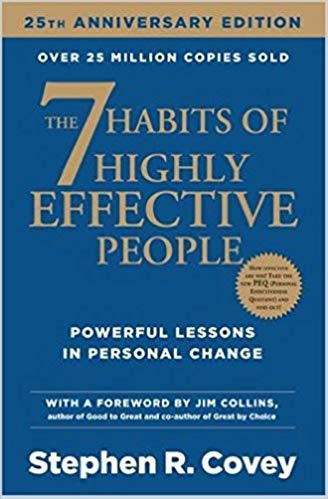

This article is an excerpt from the Shortform summary of "The 7 Habits of Highly Effective People" by Stephen Covey. Shortform has the world's best summaries of books you should be reading.
Like this article? Sign up for a free trial here .
Changing your paradigm brings powerful, dramatic change because it introduces a whole new way of thinking. This inevitably leads to a change in attitudes, behaviors, and relationships. But you may ask: how to change your paradigm? What does paradigm mean?
You can work on how to change your paradigm and about the types of paradigms as you practice self awareness.
What is a Paradigm, and How Can You Change it?
What does paradigm mean? Thomas Kuhn introduced the term “paradigm shift” to describe major scientific breakthroughs in his book, The Structure of Scientific Revolutions. There are many types of paradigms, and in all areas of life, paradigm shifts have shaped history. This paradigm shift definition is crucial to understanding what is means to change your paradigm.
- Copernicus’s claim that the planets revolved around the sun was a paradigm shift from the belief that the earth was the center of the universe.
- Before scientists developed the germ theory, large numbers of women and babies were dying during childbirth and more soldiers died from infections in minor wounds than major battlefield traumas. But the concept that germs existed — a paradigm shift — led to drastic improvements in medical outcomes.
- The creation of democracy was a paradigm shift from the long-held tradition of monarchies. This radical change created an entirely different way of forming and regulating government.
To change your paradigm doesn’t always change things for the better; for example, the progression from Character Ethic to Personality Ethic was a paradigm shift that moved to emphasize quick fixes over foundational improvements. But the paradigm shift definition doesn’t exactly mean you have to change it all at once.
Paradigms can change quickly — through life-altering experiences — or gradually.
Here are some paradigm examples. Covey was on a New York City subway one Sunday morning, and all the passengers in the train car were quiet and calm until a man and his children boarded. The loud and unruly children irritated passengers and changed the atmosphere in the car, while the man sat and did nothing. Covey eventually asked the man to try to control his children, and the man replied that they were coming from the hospital where the children’s mother had just died; the man said he was at a loss, and the children didn’t know how to handle grief either. That insight caused an instant for Covey, whose irritation was replaced with sympathy.
On the other hand, Covey tells the story of when he and his wife were concerned about their son, who was struggling academically, socially, and athletically. They encouraged him to keep trying, reinforced his successes, and assured him that things would get better — but things weren’t getting better.
Eventually Covey and his wife realized that behind all their encouragement, they saw their son as inadequate: They were comparing him to social and cultural standards, which caused them to view his actions as shortcomings, rather than accepting and celebrating him for his unique talents and assets. Trying to encourage their son in these ways and attempting to protect him from feeling failure and social ridicule was actually sending the message that who he was wasn’t good enough.
To correct their course, Covey and his wife began to give their son more space to face challenges but also to get through them on his own, to step into his own identity, to develop self-worth and gain confidence. Soon their son began to excel where he had previously struggled: academically, socially, and athletically. Covey and his wife made a slow and deliberate paradigm shift, which also shifted how their son saw himself. They speculate that their son’s newfound successes stemmed from his improved self-image and self-confidence.
How Do You Change Your Paradigm?
Paradigm examples can show that the process of change, no step can be skipped — just as a child must learn to first crawl, then walk, then run. We tend to understand this more easily in a physical context, but it’s also true in emotional, interpersonal and personal growth. So how exactly do you change your paradigm?
The problem with self-improvement through the Personality Ethic alone is that it attempts to make a good impression but shortcuts real personal growth by skipping the change in character. Such shortcuts are not worth the trouble, because you waste time and effort on a result that has no substance and produces short-term results.
For example, if you’re a novice tennis player and try playing with pros, you may temporarily deceive others (and even yourself) into thinking you’re better than you are, but ultimately people will see through the ruse. The most effective way to make real change is to truthfully acknowledge your skill level and work to improve it incrementally.
Sometimes business executives attempt to shortcut progress with external changes — making mergers and acquisitions, implementing new workflows, mandating workshops — when the issue is in the company’s structure or culture. These companies may benefits from exploring different types of paradigms.
Often, the way we frame a problem is the problem: If we are concerned with the symptoms instead of the underlying cause, this misdiagnosis contributes to (or, at best, does nothing to resolve) the real issue. This is the same way the Personality Ethic leads us to believe that a problem and its solution lie in the superficial realm. This making is different to figure out how to change your paradigm. Let’s explore some more paradigm examples.
- Example 1: You are a business executive or manager and try to treat your employees well, but you suspect they are not loyal and would slack off if you were out for the day. The problem may not be your employees, but your attitude about them. Do you truly have their best interest at heart? Or do you treat them as assets more than people, and perhaps they pick up on that and behave accordingly?
- Example 2: You are constantly moving and working but feel there are never enough hours in the day; you’ve tried to improve your time management and efficiency, but you still don’t feel you’re living a happy, balanced life. The problem may not be the amount of work you’re getting done or the time it takes you to do it, but rather a paradigm that’s affecting how you view your time, life, and priorities.
- Example 3: Your marriage feels like it’s lost its luster, and counseling and other efforts aren’t doing much to stoke the fire. Maybe the problem isn’t your spouse or your marriage. Maybe the problem is your views and expectations of love and a healthy marriage.
In relationships, you can shortcut real change and improvement by “borrowing strength” to force a superficial change; you may do this by flexing your authority, knowledge, experience, or physical size and strength. Borrowing strength to force change actually breeds weakness in multiple ways.
- First, it weakens the power of the borrower by making her dependent on these external symbols of supposed strength.
- Second, it weakens the other person by robbing him of the opportunity to have a genuine exchange and come to a mutually agreeable result.
- Third, it weakens the relationship by using fear and coercion in place of cooperation.
Covey tells a story of when he borrowed strength by forcing his three-year old daughter to share her new toys with friends at her birthday party. He first asked her to share, then tried reasoning with her, then bribed her with a treat, and finally threatened her with punishment; she refused each time. Feeling embarrassed at his daughter’s behavior as the other children’s parents watched, Covey forcibly grabbed the toys and handed them to the other children.
Covey had borrowed strength from his size and authority to force his daughter to share her toys. He understood in retrospect that, at her age and maturity level, she needed the emotional space to feel she had true possession and ownership of the toys before she could willingly share them. It would have been more valuable to their relationship if he had considered that insight and diverted the other children’s attention to other toys and games to give his daughter the emotional space she needed.
The Space Between Stimulus and Response
Understanding how paradigms affect everyone and recognizing your own paradigms gives you the power to find space between a stimulus and your response; in other words, when you know what’s guiding your behavior, you can make a conscious effort to refrain from acting out of those paradigms and actually choose how you respond to a person or situation.
Although this book largely focuses on identifying paradigms that you want to change, as you examine your own paradigms you’ll inevitably recognize scripts that you already have that positively impact your life. Your self-awareness and self-assessment will help you to see and appreciate the positive habits you already have, which you’ve probably taken for granted as because you were unaware of them.
Shifting your paradigm is an ongoing process, and you’re discovering answers to two important questions: what does paradigm mean, and how do you change your paradigm? Remembering the paradigm shift definition and steps to change your paradigm are crucial steps. Accomplishing a change in your paradigm can lead to incredible benefits in your personal and professional life.
———End of Preview———

Like what you just read? Read the rest of the world's best summary of "The 7 Habits of Highly Effective People" at Shortform . Learn the book's critical concepts in 20 minutes or less .
Here's what you'll find in our full The 7 Habits of Highly Effective People summary :
- How to prioritize the hundred tasks you have to focus on the one or two that really matter
- The right way to resolve every disagreement and argument
- How to avoid burning out and succeed over 20+ years






